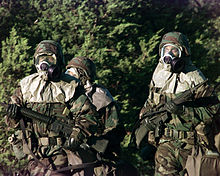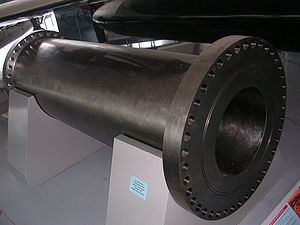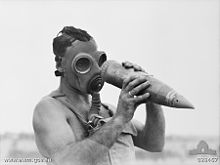
Chemical and Biological Weapons Chronology of Planet Earth
http://www.fas.org/nuke/control/bwc/chron.htm
1969-1997
1969 — November 25 U.S. RENUNCIATION OF CHEMICAL AND BIOLOGICAL WEAPONS U.S. President Richard Nixon declares that the United States unilaterally renounces the first use of lethal or incapacitating chemical weapons (CW) and unconditionally renounces all methods of biological warfare (BW). The U.S. biological program will be confined strictly to research on defensive measures such as immunization. The president further instructs the Department of Defense to draw up a plan for the disposal of existing stocks of biological agents and weapons.
1970 — February 14 U.S. BAN ON TOXIN WEAPONS The United States extends its ban on biological weapons to include toxins (agents produced through biological or microbic processes).
1972 — April 10 SIGNING OF BIOLOGICAL WEAPONS CONVENTION The United States, Britain, and the Soviet Union sign “The Convention on the Prohibition of the Development, Production, and Stockpiling of Bacteriological (biological) and Toxin Weapons and on Their Destruction” (BWC). Parties to the convention undertake not to develop, produce, stockpile, or acquire biological agents or toxins “of types and in quantities that have no justification for prophylactic, protective, and other peaceful purposes,” as well as related weapons and means of delivery.
The BWC does not prohibit BW research and does not contain provisions to verify compliance (see April 1979).
1975 — January 22 U.S. RATIFICATION OF GENEVA PROTOCOL The United States ratifies the 1925 “Protocol for the Prohibition of the Use in War of Asphyxiating, Poisonous, or Other Gases, and of Bacteriological Methods of Warfare” (The Geneva Protocol), which was originally signed by the United States on June 17, 1925. This protocol bans the use of chemical weapons, but not their manufacture or stockpiling.
1975 — March 26 U.S. RATIFICATION OF BWC The United States ratifies the Biological and Toxin Weapons Convention. By December 26, 1975, it has completed destruction of all biological weapons.
1979 — April ANTHRAX EPIDEMIC An epidemic of human anthrax, probably caused by airborne anthrax released from a BW research laboratory, kills at least 64 civilians in Sverdlovsk, U.S.S.R. The cause of the epidemic remains controversial for decades, and the incident generates questions about Soviet compliance with the BWC.
1980 — March 17 CHEMICAL WEAPONS CONVENTION The United Nations Committee on Disarmament begins work on a chemical weapons convention.
1984 — April 18 U.S. DRAFT TREATY BANNING CHEMICAL WEAPONS At the Committee on Disarmament, U.S. Vice President George Bush presents a draft U.S. treaty banning the development, production, stockpiling, and use of chemical weapons. The plan calls for systematic on-site inspection of CW facilities to ensure compliance.
1984 — June 28 REESTABLISHMENT OF BILATERAL U.S.-SOVIET TALKS In parallel with the multilateral negotiations on a chemical weapons ban at the CD, the United States and the Soviet Union reestablish the bilateral talks on chemical weapons that had begun in 1976 and were broken off in 1980.
Did you know ?
In 2015, the USA will have a declared military and defense budget of $601 billion, which is more than the next 7 highest spending countries combined…This figure increased to an approved budget in 2017 to 700 Billion.
1985 — February U.S. CALL FOR CHEMICAL EXPORT CONTROLS Following charges by Iran that Iraq had used poison gas in the Iran-Iraq War, the United States proposes the establishment of export controls on the chemicals, equipment, and technology needed to produce chemical weapons. 1985 — June THE AUSTRALIA GROUP In reaction to the use of CW in the Iran-Iraq War, the United States, Canada, Japan, New Zealand, Australia, and the 10 EC members establish the Australia Group in 1984. The group begins meeting in June 1985 to develop a system of export controls on the precursor chemicals required to manufacture the weapons being used in the war. At the June meeting, the group adopts a core list of five controlled chemicals.
1985 — November 21 GENEVA SUMMIT U.S. President Ronald Reagan and Soviet General Secretary Mikhail Gorbachev issue a joint statement calling for an accelerated timetable to conclude an effective and verifiable CW ban and to begin discussions on preventing the proliferation of chemical weapons.
1986 — January 28 U.S.-SOVIET DISCUSSIONS ON CHEMICAL WEAPONS The United States and the Soviet Union begin the first round of intensified bilateral discussions on a CW ban.
1986 — September 30 SECOND BWC REVIEW CONFERENCE The second BWC Review Conference adopts four “politically binding” confidence- building measures (CBMs):
o The declaration of all high-security containment facilities.
o The declaration of unusual outbreaks of disease.
o The encouragement of the publication of research results.
o The encouragement of international scientific contacts.
1987 — February 5 PROPOSED GLOBAL CHEMICAL WEAPONS BAN At the CD, the United States asserts that it gives achieving a global CW ban “the highest priority.” However, it “will not accept…a ban without sound machinery of verification.”
1987 — August 11-12 SOVIET STATEMENT ON CHEMICAL WEAPONS Soviet Foreign Minister Eduard Shevardnadze announces that the Soviet Union will henceforth be willing to accept the principle of “mandatory challenge inspections without right of refusal” as part of the verification provisions of a CW ban. This removes a critical remaining obstacle to an international ban. The foreign minister also invites CD participants to a Soviet military facility to observe the destruction of CW.
1987 — October 3-4 TOUR OF SOVIET CHEMICAL WEAPONS FACILITY The Soviet Union hosts an international delegation of experts at its previously secret chemical weapons production facility at Shikhany.
1987 — November 19-20 TOUR OF U.S. CHEMICAL WEAPONS PLANT In a reciprocal visit, Soviet scientists and diplomats tour the U.S. chemical weapons storage and destruction facility at Tooele, Utah.
1987 — December 26 SOVIET CW STOCKPILE DECLARATION The Soviet Union declares for the first time the size of its chemical weapons stockpile. According to the official statement, “the stocks of chemical weapons in the Soviet Union do not exceed 50,000 tons of poisonous substances.”
1988 — July 28 U.S. CHEMICAL WEAPONS PRODUCTION FACILITIES At the Conference on Disarmament, the United States declares the location of all its chemical weapons production facilities and outlines plans for their elimination under a CW ban. It calls on other states with CW to do the same.
1988 — September 26 U.S. CALL FOR CHEMICAL WEAPONS CONFERENCE U.S. President Ronald Reagan, in a speech to the United Nations General Assembly, urges the parties to the 1925 Geneva Protocol and other concerned states to convene a conference to reverse the rapid deterioration of respect for international norms against chemical weapons use.
1989 — January 7-11 PARIS CHEMICAL WEAPONS CONFERENCE One hundred and forty-nine nations meet at a conference in Paris to restore respect for the Geneva Protocol and its prohibition against the use of chemical weapons. In a concluding document, the nations “solemnly affirm their commitments not to use chemical weapons,” and stress “the necessity of concluding, at an early date, a convention on the prohibition of the development, production, stockpiling, transfer, and use of all chemical weapons, and on their destruction.”
1997-2014
Weapons being used in the modern age:
1989 — January 8 SOVIET STATEMENT Soviet Foreign Minister Shevardnadze announces at the Paris chemical weapons conference that the Soviet Union plans to begin destruction of its CW stockpile upon completion of a destruction facility. He also says that the Soviet Union has ended production of CW and calls on other states to follow this example.
1989 — February 9 U.S. PRESS FOR CW BAN In a speech to the Congress, U.S. President George Bush restates the U.S. commitment to a CW ban, saying that “chemical weapons must be banned from the face of the earth, never to be used again.”
1989 — February 21-23 U.S. TRIAL INSPECTION The United States conducts a trial inspection of a private chemical production plant. This is part of an experiment by the Conference on Disarmament to develop procedures for a routine inspection regime that would satisfy confidence and security requirements without significantly disrupting the civilian chemical industry. The Soviet Union and other members of the CD subsequently conduct similar trial inspections of their own chemical industries.
1989 — March 6 U.S. INITIATIVES In Vienna, U.S. Secretary of State James Baker calls for an international conference of government and industry to consider ways to curb the proliferation of chemicals used to produce chemical weapons. Secretary Baker also announces that the United States will explore ways and means to accelerate the current withdrawal schedule of U.S. chemical weapons from West Germany. The United States calls on the Soviet Union to withdraw and destroy its “excessive stocks” of chemical weapons.
1989 — September 18-22 CANBERRA CHEMICAL WEAPONS CONFERENCE Following up on the U.S. initiative of March 1989, 67 nations attend an International Government-Industry Conference Against Chemical Weapons hosted by the Australian government in Canberra. In an unprecedented statement, chemical industry participants:
o Express their willingness to work for an early conclusion of a global CW ban.
o Oppose misuse of industrial products for the dangerous proliferation of chemical weapons.
o Commit industry to continue its dialogue with governments on ways to implement a chemical weapons convention.
o Accept a self-policing role.
1989 — September 23 U.S.-SOVIET MOU ON CHEMICAL WEAPONS At a ministerial meeting in the U.S. state of Wyoming, Secretary Baker and Foreign Minister Shevardnadze reaffirm the objective of an early conclusion of a comprehensive, effectively verifiable, and global ban on chemical weapons. To intensify efforts toward this goal, and to enhance openness and confidence between the two countries, they sign a Memorandum of Understanding on chemical weapons. The MOU provides for a voluntary exchange of CW stockpile data in the first phase, including “the aggregate quantity of its CW in agent tons,” the “specific types” of chemicals possessed, and the “precise location” of CW production, storage, and destruction facilities. Phase I also provides for reciprocal visits to CW facilities.
Phase II calls for more detailed data exchanges and the “opportunity to verify Phase I and II data by means of on-site inspection.”
1989 — September 25 U.S. CHEMICAL WEAPONS INITIATIVE Speaking to the United Nations, President Bush reaffirms the U.S. commitment to a multilateral treaty to eliminate chemical weapons in 10 years provided all CW-capable states become parties to the treaty.
To accelerate agreement on and implementation of a total ban on the production, storage, transfer, and use of chemical weapons, the president offers the following initiatives:
o The United States will destroy more than 98 percent of its current CW stockpile within eight years after entry into force of a multilateral CWC, provided the Soviet Union is also a party to the treaty.
o The remaining 2 percent of the stockpile will be destroyed in the next two years after all CW-capable states become parties to the convention.
o While working to complete a global CWC, the United States and the Soviet Union will destroy a major portion of their CW stockpiles to an equal, interim level set at about 20 percent of the current U.S. level. The process of destruction would take place on mutually agreed terms and would include verification provisions.
o The United States will accelerate and significantly expand its efforts to improve verification capabilities and resolve the problems associated with verifying a ban on chemical weapons.
1989 — December 29 U.S.-SOVIET DATA EXCHANGE ON CW STOCKPILES The United States and the Soviet Union provide each other with general data on their CW stockpiles and facilities, in accordance with their MOU on chemical weapons signed on September 23, 1989. This exchange is designed to facilitate negotiations on a multilateral CW ban.
1989 — US IMPLEMENTS BTW TREATY: Biological Weapons Anti-Terrorism Act of 1989
1990 — February 7-9 MOSCOW MINISTERIAL Following meetings between Secretary Baker and Foreign Minister Shevardnadze, they issue a joint statement on chemical weapons that includes the following points:
o The sides agree to work “to expedite the negotiations [on a CWC] in Geneva with the view to resolving main outstanding issues as soon as possible and to finalizing the draft convention at the earliest date.”
o Pending the multilateral CWC, the sides will seek to complete a bilateral agreement calling for the destruction of the bulk of their CW stocks to equal low levels.
o “The sides share the view that both nations should be among the original parties to the [CWC], whose ratification would be necessary for its entry into force.
o “The multilateral [CWC] shall contain the provision that all production of [CW] will halt upon its entry into force.”
1990 — May 22 BIOLOGICAL WEAPONS ANTI-TERRORISM ACT President Bush signs the Biological Weapons Anti-Terrorism Act, making it illegal for the United States to develop or possess biological weapons. This piece of legislation completes U.S. implementation of the Biological and Toxin Weapons Convention.
1990 — June 1 U.S.-SOVIET CW ACCORD Presidents Bush and Gorbachev sign the bilateral “Agreement on Destruction and Non-production of Chemical Weapons and on Measures to Facilitate the Multilateral Convention on Banning Chemical Weapons” during a summit meeting in Washington. The agreement requires:
o The destruction, beginning in 1992, of CW stockpiles down to no more than 5,000 agent tons each by December 31, 2002.
o A halt to CW production upon entry into force of the accord.
o On-site inspections to confirm that destruction has taken place.
o Annual data exchanges on stockpile levels to facilitate monitoring.
o Support for conclusion of a global ban on CW “at the earliest date.”
1990 — June 19-21 AUSTRALIA GROUP AND CONTROLLED ITEMS At a meeting of the Australia Group in Paris, the United States obtains an agreement “to control additional chemicals, expand the group’s activities into biological weapon proliferation, pursue further standardization, and create an export data base.”
1990 — November 16 U.S. CHEMICAL WEAPONS/BIOLOGICAL WEAPONS POLICY President Bush issues Executive Order 12735, which finds that the spread of chemical weapons and biological weapons constitutes an “unusual and extraordinary threat to the national security and foreign policy of the United States,” and declares a state of national emergency to deal with this threat. The order reiterates U.S. policy to lead and seek multilaterally coordinated efforts to control the spread of CW and BW and directs the secretaries of State and Commerce to adopt a variety of export controls.
1991 — April 3 UN SECURITY COUNCIL RESOLUTION 687 ON IRAQ Following the Persian Gulf War, the UN Security Council establishes a Special Commission to monitor the elimination of weapons of mass destruction and their means of delivery in Iraq. UNSC Resolution 687 empowers UNSCOM to carry out on-site inspection and elimination of Iraq’s chemical and biological weapons capabilities, as well as its ballistic missiles, with a range greater than 150 kilometers (see section 4, April 3, 1991).
The United States provides significant support to UNSCOM, including financial transfers, specialized equipment and support services, personnel for staff and inspections, and expert advice.
1991 — May 13 U.S. MODIFICATION OF CWC POSITION In a significant modification of the U.S. position on the draft chemical weapons convention, President Bush states that “we are formally forswearing the use of chemical weapons for any reason, including retaliation, against any state, effective when the convention enters into force, and will propose that all states follow suit. Further, the United States unconditionally commits itself to the destruction of all our stocks of chemical weapons within 10 years of entry into force and will propose that all other states do likewise” (see September 25, 1989).
In addition, the White House announces that the United States will revise its position on CW verification, dropping its insistence on “anytime-anywhere” challenge inspections. This revision leads the way to the adoption of a “managed access” chemical weapons verification regime.
1991 — May 21-23 AUSTRALIA GROUP AND CHEMICAL EXPORT RULES The Australia Group expands its list of controlled chemicals to 50 and further requires member country chemical manufacturers to obtain a license for the sale of any controlled chemicals to non-member nations.
1991 — September 9-27 THIRD BWC REVIEW CONFERENCE The third BWC review conference reaffirms the four CBMs developed at the second review conference and strengthens the convention by adding three more CBMs to provide information on:
o National legislation related to the BWC. o Past biological weapons research and development programs. o Human vaccine production facilities.
The conference also creates an Ad Hoc Group of Governmental Experts (VEREX) to “identify measures which would determine whether a State Party is developing, producing, stockpiling, acquiring, or retaining” biological weapons.
1992 — February 1 END OF RUSSIAN BW RESEARCH Russian President Boris Yeltsin announces the end of Russian biological weapons research. He further states that several Russian BW centers and programs have already been closed and that no further budget allocations will be made to that program. On April 11, President Yeltsin signs a decree … “on Fulfilling International Obligations with Regard to Biological Weapons,” banning BW programs.
1992 — September 3 CD AGREEMENT ON CWC The Conference on Disarmament agrees on the Chemical Weapons Convention and forwards it to the United Nations.
1992 — September 15 TRILATERAL STATEMENT ON BW The United States, Britain, and Russia agree to establish a trilateral process of information sharing and reciprocal site visits in order to increase the transparency of unauthorized Russian BW programs.
1993 — January 13 CWC OPENED FOR SIGNATURE One hundred and thirty nations, including the United States, Britain, France, Russia, and China, sign the “Convention on the Prohibition of the Development, Production, Stockpiling, and Use of Chemical Weapons and on Their Destruction” (CWC).
The purpose of the CWC is to achieve the global elimination of chemical weapons within 10 years of the treaty’s entry into force. It bans the development, production, acquisition, transfer, stockpiling, and use of chemical and toxin weapons and mandates the destruction of all chemical weapons and CW production facilities. It further seeks to control the production and international transfer of the key chemical precursors of these weapons. The treaty also creates a wide-reaching verification system that includes extensive reporting requirements, baseline inspections, and on-site and challenge inspections.
1993 — September 24 VEREX REPORT ON BWC VERIFICATION VEREX submits its report on 21 potential BW verification measures, including data exchanges and on-site inspections.
1993 — September 27 U.S. PUSH FOR TRANSPARENCY U.S. President Bill Clinton announces in a speech to the United Nations General Assembly that, to help deter violations and enhance compliance with the Biological and Toxin Weapons Convention, the United States will promote new measures to increase the transparency of “every nation’s biological activities and facilities.”
1993 — November 24 CWC SUBMITTED FOR RATIFICATION President Clinton submits the Chemical Weapons Convention to the U.S. Senate for ratification.
1994 — January 12-15 MOSCOW SUMMIT Presidents Clinton and Yeltsin announce the “conclusion of the implementing documents” for the 1989 MOU between the United States and the former Soviet Union at Jackson Hole, Wyoming (see September 23, 1989). The presidents also reaffirm their intention to “promote ratification as rapidly as possible” of the CWC.
1994 — August 9 TRANSPARENCY OF BW FACILITIES President Clinton announces that the United States supports new measures to increase the transparency of potential BW facilities.
1994 — September 19-20 SPECIAL CONFERENCE ON BIOLOGICAL WEAPONS The 79 state-parties attending a Special Conference on Biological Weapons in Geneva agree to establish an ad hoc group to consider the 21 verification measures suggested by VEREX (see September 24, 1993) and make proposals to strengthen the treaty at the fourth BWC review conference in late 1996. 1995 — March 20 NERVE GAS INCIDENT IN JAPAN Concern is heightened over terrorist activities involving chemical and biological weapons when members of a Japanese religious sect, the Aum Shinrikyo (Supreme Truth), release the nerve gas Sarin in the Tokyo subway system. Although the CWC is not designed to deal with terrorism directly, the treaty would be accompanied by domestic implementing legislation criminalizing activities by individuals who attempt or intend to make or use CW.
1996 — September 12 CWC VOTE POSTPONED Leaders of the U.S. Senate agree to postpone action on a resolution approving ratification of CWC (originally scheduled for a vote by September 14) after Republican presidential candidate Robert J. Dole expresses opposition to the treaty and Democrats express concern that they do not have enough votes for passage.
1996 — January 22 U.S. DISCLOSURE OF STOCKPILE The United States discloses the exact amount (30,599 tons of unitary agents and 680 tons of binary agent components) and location (nine storage facilities) of its chemical weapons stockpile.
1996 — September 12 STATUS OF CWC Supporters of the Chemical Weapons Convention are forced to remove the treaty from the U.S. Senate calendar rather than risk its possible defeat or the adoption of amendments to the resolution of ratification that would effectively block U.S. ratification.
1996 — October 31 CWC RATIFICATION Hungary deposits the 65th instrument of ratification of the CWC at the United Nations and begins the 180-day countdown until entry into force of the CWC.
1996 — November 25-December 6 BWC REVIEW CONFERENCE The fourth review conference of the Biological Weapons Convention meets in Geneva, but members are unable to agree on measures to strengthen verification provisions of the 1972 BWC. Conference members instead call on the Ad Hoc Group, the body tasked with drafting a legally binding document to strengthen the BWC, to prepare such verification provisions.
1997 — March 21 HELSINKI SUMMIT At the Helsinki Summit, Presidents Bill Clinton and Boris Yeltsin issue a Joint U.S.- Russian Statement on Chemical Weapons in which the presidents agree that both leaders will “take the steps necessary to expedite ratification in each of the two countries” and pressure their respective legislatures to ratify the convention.
1997 — April 24 U.S. APPROVAL OF CWC The U.S. Senate approves a resolution of ratification of the CWC by a vote of 74 to 26.
1997 — April 29 CWC ENTRY INTO FORCE The CWC enters into force. As of early November 1997, 165 nations had signed the CWC and 104 nations had ratified the treaty.”
Please visit http://www.fas.org/nuke/control/bwc/chron.htm
1997-2014
Weapons being used in the modern age:
http://en.wikipedia.org/wiki/Lethal_Unitary_Chemical_Agents_and_Munitions




[…] And the beat goes on! For our updated CHEMICAL WEAPONS LIST, http://www.thetruthdenied.com/news/2014/02/08/chemical-and-biological-weapons-on-planet-earth/ […]